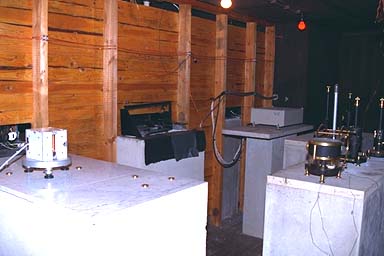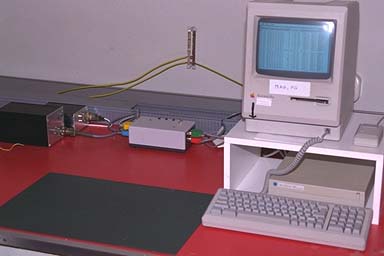Sodankylä Geophysical Observatory |
Description of Geomagnetic observations
Magnetometers
|
The Sodankylä Geophysical Observatory has been in operation since 1914. Nowadays the observatory runs continuously three vector magnetometers: a Danish fluxgate magnetometer (FG) and two photoelectric torsion magnetometers, a Polish model (called as PSM) and a Russian model (calles as RM). FG and PSM near realtime data is shown in Real-time page of SGO. The FG has been in operation since 1996, the PSM since 1983 and the RM since 1996. The PSM was first digitally sampled magnetometer sampled every 15 seconds. 2Hz sampling with 20-bit AD-converters was started in late 1995 Additionally, we have three magnetometers to measure the total magnetic field: Canadian GEM GSM-90 and GSM-90F1 Overhauser magnetometers and old proton precision magnetometer (PPM) Elsec 770 , which is nowadays used only during field measurements and difference checks at the observatory. For DI-absolute measurements (typically once a week) we have two DI-fluxgate magnetometers installed on magnetically clean Zeiss Jena 010A theodolites. SGO also participates to the regular DI-absolute observations of IMAGE sites in Northern Finland. |

Magnetometers at variometer house.
|
| The Danish DMI flux gate magnetometer (FG) has been used for the definitive data of SOD since 1 Jan 2003, when it replaced PSM as a main instrument. The Polish photo torsion magnetometer (PTM) has continued as first backup instrument at the main variometer house. The Russian magnetometer runs in backup variometer house nearby the control house of the geomagnetic observatory. The sampling rate of the FG, PSM and RM magneometers is 2 Hz. Due to impulse response of the instruments the data is suitable with for the periods longer than 3 seconds. The Overhauser magnetometer GEM GSM-90 has a sampling rate of 0.2 Hz. | |
| All magnetic data are available free of charge for scientific and educational purposes, but only one-minute data is provided on-line. One-minute values are averages of the time interval of +/- 30 seconds around the full minute: the value of minute 16 is the average of the values between 15 min 30 second and 16 min 30 s. If the first letter of the filename is "K" then the data are final; "P" refers to preliminary data. For the final data we obtain the final base lines for the variometers only about three months after the end of the respective year. See the formats of the files. |

Digital recording of geomagnetic field |
Pulsation magnetometers
In addition, SGO operates several pulsation magnetometers in Kilpisjärvi, Ivalo, Sodankylä Rovaniemi, Oulu and Nurmijärvi.
Pulsation magnetometer chain is decribed in Pulsation MeasurementsMagnetic Indices
SGO has determined the so-called K index since 1914. The Q index has been scaled since 1957 (for more details of the K and Q indices, see e.g., J. Bartels, The technique of scaling indices K and Q of geomagnetic activity, Ann. Intern. Geophys. Year 4, 215-226, 1957). The K index is 3 hours index for 8 time intervals of the UT-day: 0-3, 3-6, 6-9, 9-12, 12-15, 15-18, 18-21 and 21-24 UT. The Q index is similar to the K index, but it is determined from 15-min intervals. Until 1975, the Q time intervals were centered around 0, 15, 30 and 45 min past the hour. Since the beginning of 1975, the Q index has been determined from the data taken during the intervals 0-15, 15-30, 30-45 and 45-60 min past the hour. We produce two kinds of K indices, K(hd) obtained from H and D components, as done by most observatories in the world, and K(hdz) obtained from all (H, D and Z) components. We have derived K(hd) since 1914 and K(hdz) since 1968. In the K(hdz)-files we tabulate all components separately, the sum of the K indices (only for historical reasons) and also the Ak indices for every day for both K(hd) and K(hdz) (for more details on the Ak index, see. e.g., J. Bartels, An attempt to standardize the daily international magnetic character figure. IATME Bull., 12e, 109-138, 1951). See the formats of the files.
Other Stations
Data of the following stations, run by other institutes, are also available. These stations, including Sodankylä, extend from the auroral region in northern Finland to the sub-auroral region in southern Finland.
- Oulujärvi is one auxiliary magnetic station of SGO. Absolute and variation rooms were built in 1992 and a Danish FGE magnetometer was installed in November 1992. Absolute measurements have been done two or three times per year.
- Hankasalmi is a magnetic station of the Nurmijärvi observatory. A Danish FGE magnetometer was installed in July 1992 on top of an underground concrete pillar. Absolute measurements are done during the summer.
- Nurmijärvi is the geophysical observatory of the Finnish Meteorological Institute (FMI) started in 1952. The variation room of the observatory is equipped with a Polish TPM magnetometer and a Danish FGE magnetometer. The analog La Cour was in operation until 31st December 1995. Absolute measurements are done once a week.
DI-fluxgate instruments and proton magnetometers are used for absolute measurements at all the stations. Timing is provided by GPS, DCF or Omega receivers. NUR, HAN and OUJ are also stations of the IMAGE magnetometer chain. SOD and NUR send their data also for INTERMAGNET filing.
Last modified: 2019-07-05, 07:28:27.


